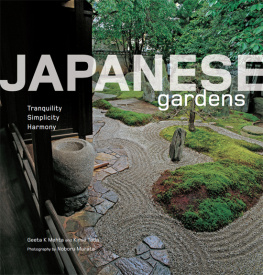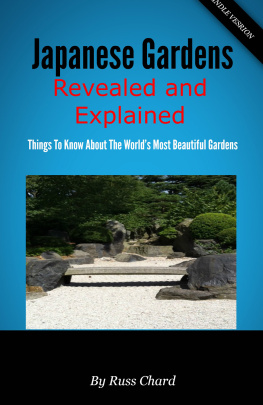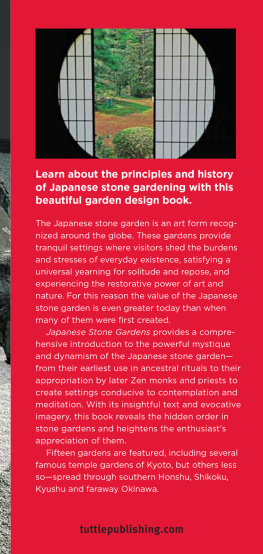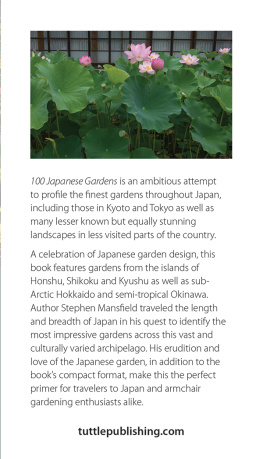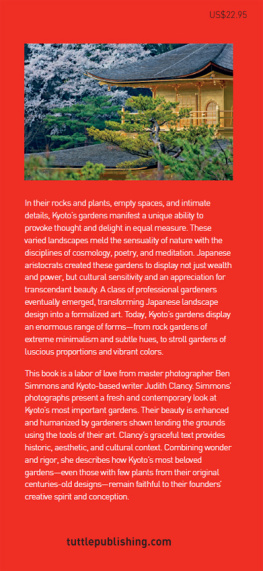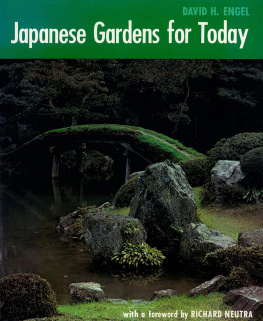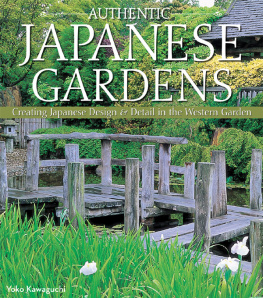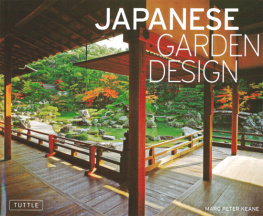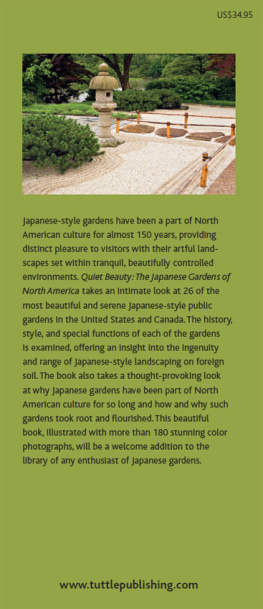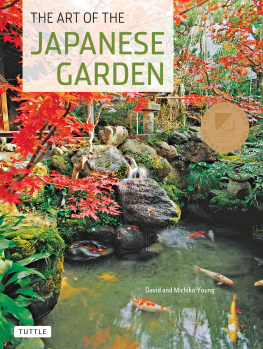Acknowledgments
Whom should one thank for making possible a book on gardens besides time, sunshine, earth, water and breeze? The humble work of the authors in bringing the beauty of the gardens in this book to the readers was greatly aided by the help and goodwill of many people and we thank them all from the bottom of our hearts. We especially wish to acknowledge photographic assistant Tomoko Osada, as well as architect Sytse de Maat for his insights, and Arjun Mehta who helped with our research. We would also like to thank Tatsumi Azuma, Kinya Sawada and Chieko Kanamori for introducing us to some lovely gardens in Hiroshima and Kanazawa. A very special thanks to Kaoru Murata, who acted as project coordinator for this book.
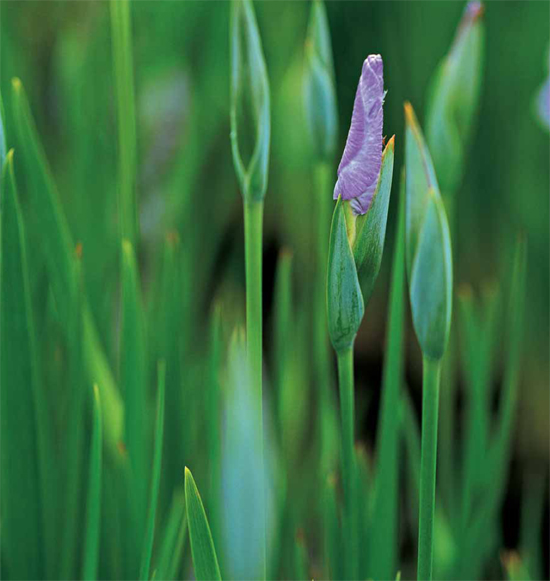
contents
Published by Tuttle Publishing, an imprint of Periplus Editions (HK) Ltd., with editorial offices at 364 Innovation Drive, North Clarendon, Vermont 05759 USA and 61 Tai Seng Avenue #02-12, Singapore 534167.
Text copyright 2008 Periplus Editions (HK) Ltd.
Photos copyright Noboru Murata
Project Coordinator: Kaoru Murata
All rights reserved. No part of this publication may be reproduced or utilized in any form or by any means, electronic or mechanical, including photocopying, recording, or by any information storage and retrieval system, without prior written permission from the publisher.
Library of Congress Cataloging-in-Publication Data
Mehta, Geeta K.
Japanese gardens: tranquility, simplicity, harmony / Geeta K. Mehta and Kimie Tada; photography by Noboru Murata. -- 1st ed.
p. cm.
ISBN: 978-1-4629-0597-3 (ebook)
1. Gardens, Japanese. I. Tada, Kimie. II. Title.
SB458.M44 2008
712.0952--dc22
2008027111
Distributed by:
North America, Latin America and Europe
Tuttle Publishing
364 Innovation Drive
North Clarendon, VT 05759-9436 U.S.A.
Tel: 1 (802) 773-8930; Fax: (802) 773-6993
info@tuttlepublishing.com
www.tuttlepublishing.com
Japan
Tuttle Publishing
Yaekari Building, 3rd Floor
5-4-12 Osaki; Shinagawa-ku; Tokyo 141 0032
Tel: (81) 3 5437-0171; Fax: (81) 3 5437-0755
tuttle-sales@gol.com
Asia Pacific
Berkeley Books Pte Ltd
61 Tai Seng Avenue
#02-12, Singapore 534167
Tel: (65) 6280-1330; Fax: (65) 6280 6290
inquiries@periplus.com.sg
www.periplus.com
Printed in Singapore
11 10 09
5 4 3 2
TUTTLE PUBLISHING is a registered trademark of Tuttle Publishing, a division of Periplus Editions (HK) Ltd.
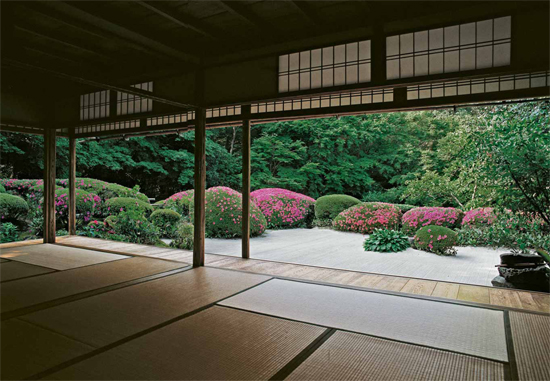
Elements often found near the pond in a Japanese garden include a yukimi-doro lantern, iris flowers, and a half moon bridge.
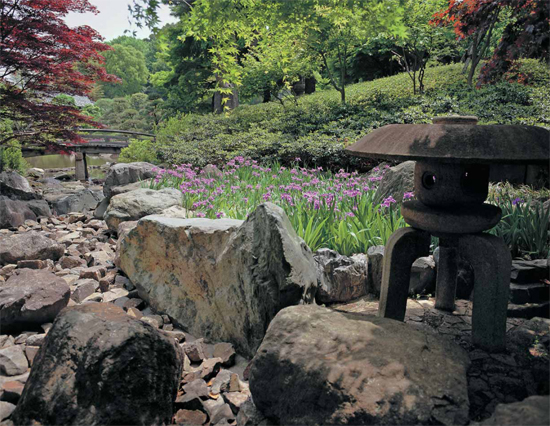
Gentle Acts of Nature, Time and Man
Between dreamtime and time,
Beyond time and thought, the fresh of the morning,
A morning of the afternoon, a morning of the evening,
A morning of life, a sparkling dewdrop,
A garden of the soul, a garden in the soul,
A garden
Gentle acts of nature, time and me
Woven in beauty, a soul nurtured
A hoe, a shear, a seed, held for now
In my transparent hands, then simply let go
From me the past, to me the future
A garden
Geeta K. Mehta
At their best, gardens are reminders of our own divinity. A beautiful garden resonates into the depths of our soul, fresh as the early morning any time we care to be fully present in it. Once it is internalized, you can return to such a garden many times, and be surrounded with a fresh, nurturing energy. How does one create and care for such a garden? This is the central question that the best Japanese gardeners have been persistent in asking and answering.
The authors of this book embarked on a beautiful journey to understand the Japanese garden. We looked at enchanting gardens where the efforts of man, nature and time complement each other, and we saw many more gardens of exquisite beauty than fit into this book. Many of these have evolved well beyond their original concept, so that the designers would scarcely recognize them now. A good example is the moss garden of Saiho-ji in Kyoto, where moss was not even a part of the original design, but has grown over hundreds of years, and now defines the garden.
While human ingenuity and geometric perfection inform most other garden traditions, Japanese gardens are different. Most gardens around the world are hierarchical, arranged around a buildingwhich is often the main reason for the gardens existence. In Japan, it is the other way around. In the best Japanese gardens, tea huts and other buildings are tucked to one side of the garden so as to be as unobtrusive as possible. It is said that aristocrats of the Heian period located their gardens on a site first, and then constructed villas in the space left over.
Japanese gardens are very different from Chinese gardens, to which they nevertheless owe a large debt. Things Chinese were revered in Japan prior to the Meiji period. Yet while some coveted plant materials used in Japanese gardens today may be traced back to China, the essence of the Japanese garden harks back to Japans pre-Buddhist roots where nature was deeply understood and held sacred. Every stone was believed to have a soul then, and the best gardeners then as now sought to understand and set each stone to express its soul. Trees are pruned back to their essence, and the leaves of autumn are prized. Plants that articulate the beauty of seasonal changes are carefully selected and situated to highlight the rhythms of nature.
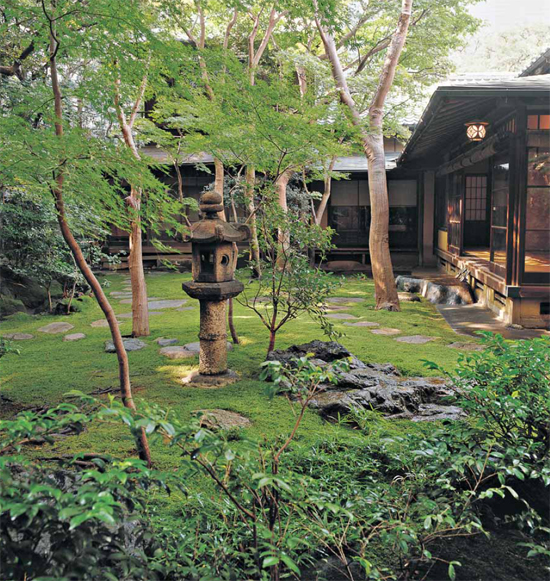
A characteristic feature of Japanese gardens is their close relationship to architecture. Each element is designed keeping the others in mind. Simply sliding away walls made of shoji doors can combine the interior and exterior spaces. Views of the garden are a major consideration in situating the buildings on the site.
Japanese gardens may be classified broadly into two groups: those meant to be experienced by entering and walking in them, and visual gardens meant to be experienced mainly with the eyes and the mind. The former category includes stroll gardens, Pure Land Jodo gardens, and tea gardens. Visual gardens were designed for contemplation and meditation and include the karesansui or dry-mountain-water gardens, and naka niwa interior courtyard gardens. Visual gardens are usually viewed from one side only, from inside a shin -style room, and are composed like three-dimensional paintings depicting an ideal landscape or a complex philosophical concept. One of the best examples of this is the abbots rock garden at Ryoan-ji temple (page 54).

